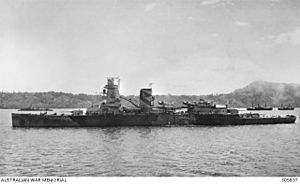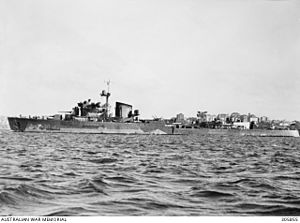Battle of Badung Strait facts for kids
Quick facts for kids Battle of Badung Strait |
|||||||
|---|---|---|---|---|---|---|---|
| Part of World War II, Pacific War | |||||||
 HNLMS De Ruyter off Java in 1942. |
|||||||
|
|||||||
| Belligerents | |||||||
| Commanders and leaders | |||||||
| Strength | |||||||
| 3 cruisers 7 destroyers 2 submarines 20 aircraft |
4 destroyers 2 transports |
||||||
| Casualties and losses | |||||||
| 1 cruiser damaged 1 destroyer sunk 1 destroyer damaged and — later scuttled — |
25 killed 83 wounded 3 destroyers damaged 1 transport damaged |
||||||
The Battle of Badung Strait was a naval battle during World War II. It happened on the night of February 19-20, 1942. This fight took place in the Badung Strait near Bali. The battle was between the Allied forces and the Imperial Japanese Navy.
Even though the Allies had more ships, the four Japanese destroyers won. They sank a Dutch destroyer and safely guided two transport ships. This battle showed how good the Japanese Navy was at fighting at night.
Contents
Why the Battle Happened
In February 1942, World War II was happening. Japanese soldiers landed on Bali on February 18, 1942. Bali is an island in the Dutch East Indies (modern-day Indonesia).
The Allies knew this was a problem. If Japan controlled Bali, they would have an airbase. This airbase would be close to the main Allied naval base at Surabaya.
Dutch Admiral Karel Doorman decided to act. He sent all his available ships to stop the Japanese. His ships were spread out, so they attacked in different groups.
The Fight Begins
The first Allied ships to attack were two submarines. These were the USS Seawolf and HMS Truant. They attacked the Japanese ships on February 18. But they didn't cause any damage. Japanese destroyers chased them away with depth charges.
Later that day, 20 planes from the United States Army Air Forces attacked. They only managed to damage one transport ship, the Sagami Maru.
The Japanese knew more attacks were coming. So, they quickly moved their ships north. Some Japanese ships, like the cruiser Nagara, left the area. The last ships to leave were the transport ships. Each transport had two destroyers protecting it.
Night Battle in the Strait
The first group of Allied ships arrived around 10:00 PM on February 19. This group included the cruisers HNLMS De Ruyter and Java. It also had the destroyers USS John D. Ford, Pope, and HNLMS Piet Hein. They saw the Japanese ships and started firing at 10:25 PM.
No ships were hit at first. The two Dutch cruisers moved through the strait. This allowed their destroyers to use torpedoes. Then, Piet Hein, Pope, and John D. Ford got closer.
At 10:40 PM, a powerful Japanese torpedo hit Piet Hein. The Dutch destroyer sank right away. The Japanese destroyers Asashio and Oshio then fought with Pope and John D. Ford. The two American destroyers had to retreat.
In the dark, Asashio and Oshio accidentally fired at each other. They thought the other was an enemy ship. Luckily, no damage was done.
More Ships Join the Fight
About three hours later, a second group of Allied ships arrived. This group had the cruiser HNLMS Tromp. It also had the destroyers USS John D. Edwards, Parrott, Pillsbury, and Stewart.
At 1:36 AM, Stewart, Pillsbury, and Parrott launched torpedoes. But they didn't hit anything. Then, Oshio and Asashio came back to fight. There was another exchange of gunfire.
The Tromp was hit by eleven shells from Asashio. This caused serious damage to the Tromp. The Tromp also hit both Japanese destroyers. Four men died on Asashio and seven on Oshio. The Tromp later had to go to Australia for repairs.
Two other Japanese destroyers, Arashio and Michishio, joined the battle around 2:20 AM. Michishio was hit by shells from Pillsbury, John D. Edwards, and Tromp. Thirteen of her crew were killed, and 83 were wounded. She lost speed and needed to be towed after the battle.
During these fights, the American destroyer Stewart was also damaged. A shell hit below the waterline. This caused water to flood her steering room. Both groups of ships then turned away, and the battle ended.
What Happened Next

A third group of Allied ships arrived around 6:00 AM. These were seven torpedo boats. But they didn't find any Japanese ships.
The Battle of Badung Strait was a big win for the Japanese. The Japanese destroyer commanders, Gorō Yoshii and Kiyoshi Kikkawa, showed great skill. They fought off a much larger Allied force. They sank the destroyer Piet Hein. They also damaged the destroyer Stewart and the cruiser Tromp. The Japanese ships themselves had very little damage. They also kept their transport ships safe.
The Japanese quickly took control of Bali. The local Indonesian soldiers on Bali did not fight back. The Japanese also captured the airfield there. The Japanese continued to take over other islands in the Dutch East Indies. They captured Timor a few days later.
The Allied forces that fought at Badung Strait faced another big defeat. This happened in the Battle of the Java Sea on February 27, 1942. In that battle, the Dutch cruisers Java and De Ruyter were sunk. Admiral Doorman was killed. The Tromp was lucky. It was in Australia getting repairs from the Badung Strait battle.
The US destroyer Stewart was too damaged to be repaired quickly. She was in a dry-dock in Soerabaia. To stop the Japanese from capturing her, she was sunk on purpose. A year later, the Japanese raised her. They repaired her and used her as their own patrol ship, called P-102.

